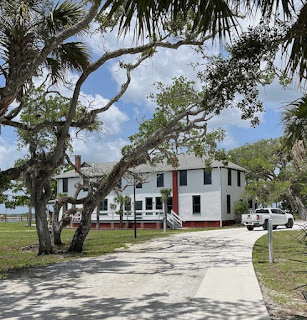 |
| Guest bedroom is furnished as it would have been in the late 1800s. (Gerri Bauer photo) |
Trading, fishing, guiding visitors - they were some of the ways pioneers in undeveloped parts of Florida made their living in the late 1800s. The Pacetti family of Ponce Inlet did so, and more, at a time when the area was a true wilderness.
Even the Ponce Inlet Lighthouse didn't exist at first. Bartolo and Martha Pacetti sold 10 acres to the U.S. government for use as a light station. The Ponce Inlet Lighthouse was constructed in 1887.
By that time, the Pacettis operated a thriving fishing resort and boarding house adjacent to the lighthouse grounds. They'd built the structure in 1881 using the $400 earned from the land sale. It was an upgrade from the wooden cottage where they had already become known for their hospitality.
In a joyful moment for history seekers, the restored Pacetti Hotel re-opened in 2024 as a public museum owned by the Ponce DeLeon Inlet Lighthouse Preservation Association. I recently toured the hotel and enjoyed every minute.
 |
| The Pacetti Hotel is now a public museum. (Gerri Bauer photo) |
There's a lot of history packed into the building, now named the Constance D. Hunter Historic Pacetti Hotel. And several people worth noting, from modern times to the past:
- Constance Hunter, whose foundation partially funded the recent restoration
- The Gamble family of Procter & Gamble fame. Olive Gamble did the first restoration. She and subsequent relatives hosted family and friends there.
- Fishing and hunting guide and building caretaker Jesse Linzy, who lived at the hotel and worked for the Pacettis starting in 1907. In the 1930s, he married "Miss Ida," the personal cook and maid who arrived with Olive Gamble. In the short-sighted ways of the era, we don't know her surname before she became Ida Linzy.
Bartolomeu Clemente Pacetti was born about 1823. He was a descendent of the Pons and Pacetti families who were part of the ill-fated Turnbull Colony (1760s-1770s) in nearby New Smyrna Beach. The colonists arrived from Minorca, Greece and Italy as indentured servants. Most went north to St. Augustine when the colony collapsed, but others stayed nearby. Bartolo inherited some of the Pons family land.
Martha Jane Wickwire Pacetti was born in Florida in 1844 to pioneers from Vermont and Georgia. Her local roots also ran deep. Her ancestors included the Osteen family, whose name lives today in the Florida community of the same name in the same county.
The Pacettis had five children. The family lived and ran their popular resort in a beautiful, bountiful waterfront location. But it was isolated. And the living wasn't easy in the 1880s, 1890s and early 1900s. It was nonstop work, as you learn from museum exhibits.
Martha gained a reputation as an excellent cook of the fish and wild game the land and sea produced. One visitor said she set a "capital table" and was said to be the best fish cook in Florida. Bartolo, his sons Gomez and Bert (who later became a federal wildlife officer), along with Jesse, became renowned as guides.
 |
| The Ponce Inlet Lighthouse is seen through a window in Pacetti Hotel. (Gerri Bauer photo) |
As the years continued, notables such as businessman James Norris Gamble and artist William Aiken Walker found their way to the resort, along with many others. They included the lighthouse builders, its keepers and their families.
Today, visitors can tour the beautifully restored building and view bedrooms furnished as they were in the different time periods. They can immerse themselves in period details shown in exhibits and explained in wall board displays that include period photos. A short video acquaints guests with the property's history. You can even rent the facility for weddings and other events. Learn more at www.ponceinlet.org
Go see the hotel. And the lighthouse complex, which I'll write about next month. They are both so worth it.
 |
| Side view of the waterfront hotel. (Gerri Bauer photo) |








